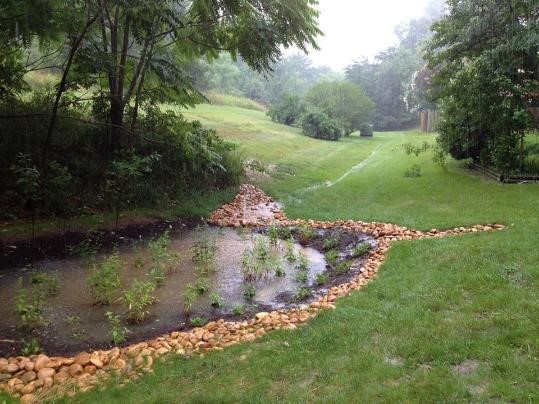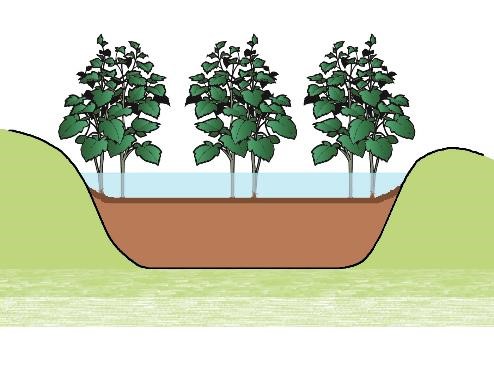A rain garden is a great way to handle runoff on your property, but it is important to do it right. Rain gardens serve the dual purpose of improving landscape aesthetics and draining stormwater in an environmentally friendly and natural way. Whether you are planning to install a rain garden at home or simply curious about the process, read on to learn about some common myths and misconceptions about rain gardens.

Please note that this article is intended for homeowners who are interested in building a rain garden voluntarily on their property. Design, construction, and maintenance are simpler and less stringent than when a rain garden is required as part of the development process. Rain gardens built to comply with stormwater management requirements should be designed and built according to the standards and specifications provided by the local jurisdiction where the rain garden will be built.
Myth #1: That spot in your backyard that is always soggy and never dries out is a perfect place for a rain garden.
Fact: A rain garden is not a wetland. A rain garden is supposed to collect rain water, hold the water for a short period of time, and allow the water to seep into the surrounding soil within 24 to 48 hours. It is designed to absorb runoff, filter it through the soil, and remove sediment, nutrients and pollutants. Within 1-2 days after a rainstorm, the rain garden should be dry. However, if the surrounding soil cannot absorb water, the rain garden will gradually turn into a wetland with standing water.
Wet spots in a yard can be used to build a rain garden if the soil inside the rain garden is well amended or replaced. Even so, such a rain garden often needs to be equipped with an underdrain, which could increase building costs significantly.
Myth # 2: Rain gardens require only wetland plants.
Fact: Plants selected for the rain gardens need to tolerate durations of both wet and dry conditions. However, rain gardens should only stay wet for a maximum of 24 to 48 hours to avoid mosquitos and other pests. Rain garden plants also need to endure periodic drought conditions during summer months. Plants should include natives that can tolerate both very wet and very dry soil conditions. Some plants that typically do well in rain gardens include Winterberry Holly, Virginia Sweetspire, Chokeberry, Viburnum, Black-Eyed Susan, Joe Pye Weed, and Mountain Mint. For more ideas, see the Selecting Plants and Landscaping a Rain Garden presentation at the Northern Virginia Regional Commission website.
Myth # 3: Rain gardens cannot be built on slopes.

Fact: Small rain gardens can be built on relatively mild slopes (5% slope or 6 inches of drop for every 10 feet of slope length). When building on a slope, the rain garden needs a berm to protect the ponding area on top of the rain garden (see diagram). The berm may require more material, building and labor, which could cause costs to increase.
Myth # 4: Rain gardens are difficult to maintain.
Fact: If a rain garden is suitably located, properly built, and adequately planted, it will need minimal maintenance. However, just like any other garden, it does need periodic weeding and other basic care.
Myth # 5: Determining the right size of a rain garden is complicated and may require professional help and additional cost.
Fact: The size of a voluntarily built rain garden on your property is up to you! No particular sizing is required and it can depend on the resources available. In order to learn about recommended ponding area or depth of amended soil, you can contact your local soil and water conservation district or Master Gardeners, who might be able to provide you with technical assistance in planning and sizing your rain garden at no cost. For more information, see Rain Garden Design and Construction for Homeowners.
Myth # 6: Rain gardens are expensive to build.
Fact: The cost of building a small residential rain garden is between $3 and $10 per square foot of rain garden surface area. A typical homeowner rain garden with a surface area of 150 square feet might cost between $450 and $1,500. Costs can depend on soil conditions, location, type and number of plants, and whether construction is done by the homeowner or a hired contractor. Items that can increase construction costs include replacing the soil, increasing the type and number of plants, and installing an underdrain.
Myth # 7: A permit is needed to build a rain garden.
Fact: In Fairfax County, you do not need a permit if you disturb less than 2,500 square feet of your yard during the installation of your rain garden. For more information about when you need a permit, see Before You Dig.
Periodically, NVSWCD co-hosts residential rain garden workshops in partnership with the Northern Virginia Regional Commission and Arlington County Department of Environmental Services. For materials and future workshop dates, see the Northern Virginia Regional Commission website.

